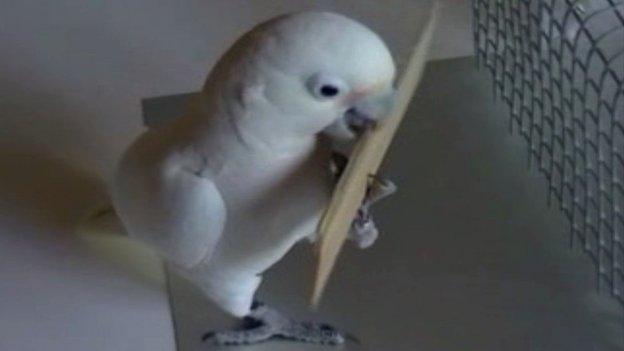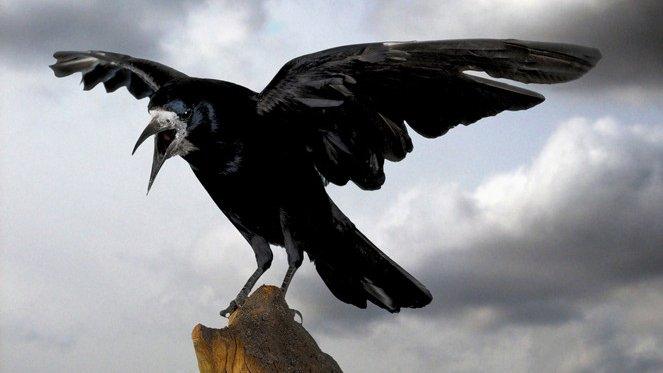Cockatoos teach tool-making tricks
- Published
Figaro, the innovative cockatoo, demonstrates tool-making to another bird
They may be in a battle with the crow family for the title of most intelligent bird.
And Goffin cockatoos have now shown an impressive ability to learn from one another how to use and even how to make tools.
A team of researchers has discovered that the birds emulate tool-making tricks when they are demonstrated to them by another bird.
The results are published in the Royal Society journal Proceedings B.
The researchers are interested in what they call "technical intelligence", which is essentially animals' ability to use objects to solve problems.
"Cockatoos are very interesting for this, because they're very playful with objects," explained lead researcher Dr Alice Auersperg, from the University of Oxford and the University of Vienna.
She and her colleagues had already noticed that one of birds in their research aviary, named Figaro, spontaneously used sticks to drag nuts under the bars.
Figaro also worked out how to make his "fishing sticks" by stripping long, thin pieces off a wooden block in his enclosure.
"So we had one innovator, and a very important aspect of innovation [is] how it can spread in a group," Dr Auersperg explained to BBC News.
To investigate this, the researchers set up an experiment where six birds were shown, by Figaro, how to strip a block and fish for a nut.
After watching the demonstration, most of the birds were able successfully to make their own strip of wood, and use it to retrieve a piece of food.
Fishing technique
"This was the interesting thing," said Dr Auersperg "They were successful and interacting with the materials, but they weren't copying Figaro - they devised their own strategy of obtaining the reward."

The birds make 'food fishing sticks" by stripping blocks of wood
Figaro, she explained, had developed is own method of using the tool as a sort of rake.
Holding the end between his jaw and his tongue, the inventive bird would continually shift the position of the stick to rake the nut towards himself.
On seeing this demonstration, the birds in this study achieved the same result more quickly by flicking the nut towards themselves with the stick.
"It's very interesting that they come up with this more effective technique," said Dr Auersperg.
"It confirms how innovative and how adaptable this species is to novel problems."
The scientists say it is particularly surprising how tool use can be "socially transmitted" in a bird that has great difficulty holding a straight tool in its curved beak.
Cockatoos also have no ecological reason to hold and use such straight, thin objects, as they do not build nests in the wild.
But Prof Richard Byrne from the University of St Andrews is not convinced that the cockatoos are quite so "advanced" in their behaviour.
"To emulate, you have to gain some real understanding of what's going on," he told BBC News. "In this case, the cause-and-effect of using a tool in the task.
"I'd plump for a simpler explanation."
He described something called "stimulus enhancement" - where the birds are more likely to interact with objects when they see another bird doing so.
"Then [it could just be] trial and error learning," he added.
Dr Auersperg, however, is convinced that this discovery is "a very significant finding in terms of animal innovation and creativity".
- Published1 July 2014
